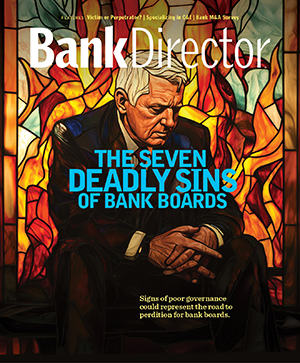
Timing is everything, if you’re prepared.

In August 2005, one of the country’s most devastating hurricanes battered the Gulf coast and severely impacted Hancock Holding Company, an $8.2-billion asset financial institution headquartered in Gulfport, Mississippi. The effects of Katrina tested President and CEO, Carl Chaney, and his team’s ability to survive when so many in that part of the country lost everything.
As a keynote speaker at Bank Director’s annual M&A event, Acquire or Be Acquired, in Scottsdale, Arizona, Chaney shared the story of how the bank’s back office operations were destroyed along with the complete destruction of a mini-branch leaving only the vault standing. However, Hancock saw this as an opportunity to help get their community back on its feet by literally laundering (washing storm tattered) money and putting it back into circulation. Two repossessed and damaged RV’s turned into portal branches as they worked their way through ravished neighborhoods putting money back into their community.
In the 90 days following Katrina, Hancock was able to grow their assets by $1.4 billion. When a disaster strikes, whether natural or economic, a board that is prepared for the opportunities will separate the leaders from the pack.
Then came the financial meltdown of 2008, and the flight to quality during this time allowed Hancock to grow another $1.1-billion in the fourth quarter of 2008, approximately 90 days after the crisis.
So how did they do it? Chaney’s process is one that he adamantly believes helped his bank take advantages of opportunities where others saw none.
1. Do your homework. Gather as much demographic and economic data on the markets your comfortable expanding into, and then study that data to make sure you are capable of succeeding there.
2. Use Visuals. Chaney recommends that you get a map, plot out those areas, and make a list of the top ten banks in those markets. Then do a competitive analysis on each one to determine what banks may become available.
3. Discuss and Decide. Gather the data you’ve collected, then conduct a one day board meeting off-site to go through the data, discuss each market and then prioritize them based on attractiveness. Chaney recommends that a board be picky, and take the time to fully understand how much and what type of growth the bank can manage. Make sure the board and management team is on the same page to ensure that everyone is prepared before the opportunity arises.
Chaney and his board participated in this thorough process which allowed them to acquire the failed bank People’s First of Panama City, Florida, in early December 2009. Hancock had indicated that People’s First was a bank on their list that met their criteria based on that strategic off-site meeting. So when the FDIC asked them take it over, and be able to handle transactions within the next four days during the holiday (and hunting) season, his board was ready, the deal went through and Hancock opened their new branches the week before Christmas.
The bank’s recent acquisition of Whitney Holding Company out of New Orleans, Louisiana in December 2010 was another institution on the list, and with conversations already in the works, Hancock was ready to acquire the $11.5-billion asset institution when the opportunity finally presented itself.
“It’s time for attitude adjustment,” Chaney said in his closing. “Stop being ashamed and be proud to be a community banker.” Any bank with a board that is prepared and remains disciplined can be a very successful institution. “Good deals rarely come on payday.”

